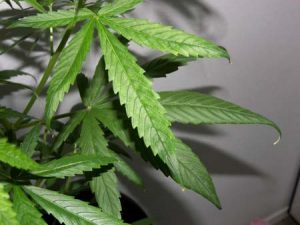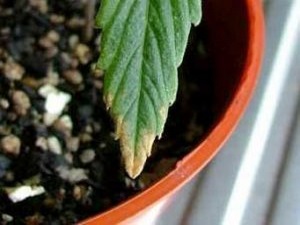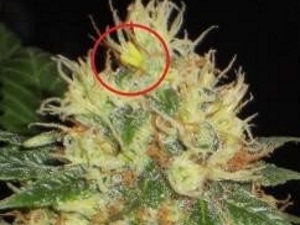Watering
Just as all living things need water to survive, so do cannabis plants. As a matter of fact, cannabis plants are about 90% water and use that water through the process of photosynthesis to turn light and carbon dioxide into food for nourishment. With the right pH balance, water also helps carry important nutrients to the plant which in turn enables those nutrients to be absorbed into the root system. So, it’s pretty obvious that water plays a vital role in keeping your plants healthy and thriving. As important as water is for your cannabis plants, too much can do just the opposite.
Effects of Overwatering
The most common side effect of overwatering is root rot. When this happens, the roots are deprived of vital oxygen and are unable to ‘feed’ the rest of the plant. Telltale signs of root rot are leaves that are yellowing and roots that are brown and twisted which can be an indication of infection.
Getting it Right
There are two basic things to ensure you are watering properly.
The Planter – the proper planter actually plays an important role is getting water right. First you want to make certain that the planter is big enough to accommodate a mature plant. This is important because you do not want to transplant your cannabis plant more than once during its growth cycle as this could cause too much stress. Once you have the right planter, make sure it has adequate holes for drainage.
The Water – If you plan on using plain tap water, it should be left out for at least 24 hours before you use it. This will allow the pH level to settle and ensure that your water is room temperature so as not to cause shock to the roots. It is recommended that before using the water you test the pH level with a testing strip. If the pH level needs to be adjusted that can be done using a pH down solution. If using soil as your grow medium the pH level should be about 6.0 – 6.8. Other grow mediums typically require a lower pH level, but it is best to check with your garden supplier to determine the right level for whatever medium you are using.
Once the water and the pH levels are correct, you can add nutrients to the water. Remember that nutrients should only be added after the seedling stage. You need to use caution with nutrients as they cause shock if introduced too early. For this reason, it is recommended that you start with less than is recommended (perhaps 1/2 or 3/4 of what is suggested). Then you can slowly increase the amount until you get to what is recommended on the package.

Brown, twisted roots

Yellowing & dead leaves

Signs of root rot – Browning Tips
Never use more than the recommended amount of nutrients as this can cause ‘nutrient burn’. If nutrient burn does occur, you can simply flush out the nutrients from the soil and then resume with a smaller amount as when you first started adding them.
How Often & When to Water
Seedlings – Frequent watering is important for seedlings as they can dry out very quickly. It is typical that they need to be watered twice a day but be careful to only use a small amount of water at each watering.
Growing Phase – For larger cannabis plants, its good to let them dry out slightly, but only slightly! By letting the roots dry a little, it forces them to breath and grow looking for water and thus creating a stronger root system. If roots are left to dry out too long, it can cause drought conditions in flowering plants causing them to become hermaphroditic.
You can avoid hermaphrodite cannabis plants by avoiding placing any stress on them, especially in the flowering stage. Be sure you carefully prune and stake the plants during the pre-flowering state – before any buds start. Always keep the environment in your grow room hygienic and regularly check for mites, insects, and of course water regularly and with the right amount of nutrients.
When deciding when and how much to water, keep in mind that much of that will depend on your grow environment and what type of grow medium you are using. As a general rule of thumb, larger plants will need watering about every 2 to 3 days and only once the lights have been turned on for the day. With a soil medium, the soil should be dry down to a depth of about 5cm or about to the first knuckle of your finger.
It’s best to use a watering can to provide an even and gentle disbursement of water that has been infused with the proper amount of nutrients. You can continue watering until you see water flowing from your drainage wholes in the planter.
It’s important to be aware of when your plants are getting close to harvesting time. About two weeks prior to that, you should flush your plants with room temperature, and pH balanced water in order to rid the roots of any leftover nutrients.
You can avoid hermaphrodite cannabis plants by avoiding placing any stress on them, especially in the flowering stage. Be sure you carefully prune and stake the plants during the pre-flowering state – before any buds start. Always keep the environment in your grow room hygienic and regularly check for mites, insects, and of course water regularly and with the right amount of nutrients.
When deciding when and how much to water, keep in mind that much of that will depend on your grow environment and what type of grow medium you are using. As a general rule of thumb, larger plants will need watering about every 2 to 3 days and only once the lights have been turned on for the day. With a soil medium, the soil should be dry down to a depth of about 5cm or about to the first knuckle of your finger.
It’s best to use a watering can to provide an even and gentle disbursement of water that has been infused with the proper amount of nutrients. You can continue watering until you see water flowing from your drainage wholes in the planter.
It’s important to be aware of when your plants are getting close to harvesting time. About two weeks prior to that, you should flush your plants with room temperature, and pH balanced water in order to rid the roots of any leftover nutrients.

Signs of root rot – curled tips

Signs of root rot – burnt tips

Hermaphrodite marijuana plant
Flushing Plants Before Harvest
- The water must be pure – no added nutrients
- Use a generous amount of water and pour it directly on the soil
- Let it sit for a while. This gives the plant time to absorb any residual nutrients that may be there still
- Then flush once again with pure water
During the final 2 weeks before harvest begins, the plant will use up any nutrients that are in the plant itself.
Using a drip line for watering ensures that water will be distributed evenly and helps preventing flooding the surface of your planter.
The general guidelines for watering your cannabis plants include:
- Soak plants long enough to create a run off from the drainage wholes
- Water can pool while you are watering but should disappear once to start on the next plant
- Wait for the soil to begin drying out before the next watering
- Keep notes on when and how much you water in order to come up with a good watering schedule
- The need for water will increase as the plants grow
Cannabis plants can handle a small amount of under or over watering. Keeping notes on when and how much you water will help you maintain the proper watering schedule. As you begin to get more comfortable with how much water your plants need and when, you will see just how well your plants will continue to flourish and stay healthy through to harvest time.